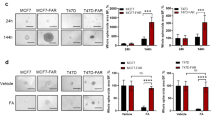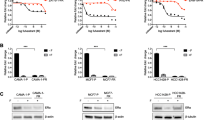Abstract
High levels of Tissue Inhibitor of Metalloproteinases-1 (TIMP1) are associated with poor prognosis, reduced response to chemotherapy, and, potentially, also poor response to endocrine therapy in breast cancer patients. Our objective was to further investigate the hypothesis that TIMP1 is associated with endocrine sensitivity. We established a panel of 11 MCF-7 subclones with a wide range of TIMP1 mRNA and protein expression levels. Cells with high expression of TIMP1 versus low TIMP1 displayed significantly reduced sensitivity to the antiestrogen fulvestrant (ICI 182,780, Faslodex®), while TIMP1 levels did not influence the sensitivity to 4-hydroxytamoxifen. An inverse correlation between expression of the progesterone receptor and TIMP1 was found, but TIMP1 levels did not correlate with estrogen receptor levels or growth-promoting effects of estrogen (estradiol, E2). Additionally, the effects of fulvestrant, 4-hydroxytamoxifen, or estrogen on estrogen receptor expression were not associated with TIMP1 levels. Gene expression analyses revealed associations between expression of TIMP1 and genes involved in metabolic pathways, epidermal growth factor receptor 1/cancer signaling pathways, and cell cycle. Gene and protein expression analyses showed no general defects in estrogen receptor signaling except from lack of progesterone receptor expression and estrogen inducibility in clones with high TIMP1. The present study suggests a relation between high expression level of TIMP1 and loss of progesterone receptor expression combined with fulvestrant resistance. Our findings in vitro may have clinical implications as the data suggest that high tumor levels of TIMP1 may be a predictive biomarker for reduced response to fulvestrant.









Similar content being viewed by others
Reference
Nawaz Z, Stancel GM, Hyder SM. The pure antiestrogen ICI 182,780 inhibits progestin-induced transcription. Cancer Res. 1999;59:372–6.
Rosenberg Zand RS, Grass L, Magklara A, Jenkins DJ, Diamandis EP. Is ICI 182,780 an antiprogestin in addition to being an antiestrogen? Breast Cancer Res Treat. 2000;60:1–8.
Hyder SM, Stancel GM. Inhibition of progesterone-induced VEGF production in human breast cancer cells by the pure antiestrogen ICI 182,780. Cancer Lett. 2002;181:47–53.
Davies C, Godwin J, Gray R, Clarke M, Cutter D, Darby S, et al. Relevance of breast cancer hormone receptors and other factors to the efficacy of adjuvant tamoxifen: patient-level meta-analysis of randomised trials. Lancet. 2011;378:771–84.
Zilli M, Grassadonia A, Tinari N, Di GA, Gildetti S, Giampietro J, et al. Molecular mechanisms of endocrine resistance and their implication in the therapy of breast cancer. Biochim Biophys Acta. 2009;1795:62–81.
Osborne CK, Schiff R. Mechanisms of endocrine resistance in breast cancer. Annu Rev Med. 2011;62:233–47.
Ali S, Coombes RC. Endocrine-responsive breast cancer and strategies for combating resistance. Nat Rev Cancer. 2002;2:101–12.
Wurtz SO, Schrohl AS, Sorensen NM, Lademann U, Christensen IJ, Mouridsen H, et al. Tissue inhibitor of metalloproteinases-1 in breast cancer. Endocr Relat Cancer. 2005;12:215–27.
Wurtz SO, Schrohl AS, Mouridsen H, Brunner N. TIMP-1 as a tumor marker in breast cancer—an update. Acta Oncol. 2008;47:580–90.
Jung KK, Liu XW, Chirco R, Fridman R, Kim HR. Identification of CD63 as a tissue inhibitor of metalloproteinase-1 interacting cell surface protein. EMBO J. 2006;25:3934–42.
Fu ZY, Lv JH, Ma CY, Yang DP, Wang T. Tissue inhibitor of metalloproteinase-1 decreased chemosensitivity of MDA-435 breast cancer cells to chemotherapeutic drugs through the PI3K/AKT/NF-small ka, CyrillicB pathway. Biomed Pharmacother. 2011;65:163–7.
Schrohl AS, Holten-Andersen MN, Peters HA, Look MP, et al. Tumor tissue levels of tissue inhibitor of metalloproteinase-1 as a prognostic marker in primary breast cancer. Clin Cancer Res. 2004;10:2289–98.
Jiang Y, Goldberg ID, Shi YE. Complex roles of tissue inhibitors of metalloproteinases in cancer. Oncogene. 2002;21:2245–52.
Willemoe GL, Hertel PB, Bartels A, Jensen MB, Balslev E, Rasmussen BB, et al. Lack of TIMP-1 tumour cell immunoreactivity predicts effect of adjuvant anthracycline-based chemotherapy in patients (n = 647) with primary breast cancer. A Danish Breast Cancer Cooperative Group Study. Eur J Cancer. 2009;45:2528–36.
Schrohl AS, Meijer-van Gelder ME, Holten-Andersen MN, Christensen IJ, Look MP, Mouridsen HT, et al. Primary tumor levels of tissue inhibitor of metalloproteinases-1 are predictive of resistance to chemotherapy in patients with metastatic breast cancer. Clin Cancer Res. 2006;12:7054–8.
Klintman M, Ornbjerg WS, Christensen IJ, Braemer HP, Ferno M, Malmberg M, et al. Association between tumor tissue TIMP-1 levels and objective response to first-line chemotherapy in metastatic breast cancer. Breast Cancer Res Treat. 2010;121:365–71.
Lipton A, Ali SM, Leitzel K, Demers L, Evans DB, Hamer P, et al. Elevated plasma tissue inhibitor of metalloproteinase-1 level predicts decreased response and survival in metastatic breast cancer. Cancer. 2007;109:1933–9.
Lipton A, Leitzel K, Chaudri-Ross HA, Evans DB, Ali SM, Demers L, et al. Serum TIMP-1 and response to the aromatase inhibitor letrozole versus tamoxifen in metastatic breast cancer. J Clin Oncol. 2008;26:2653–8.
Bjerre C, Knoop A, Bjerre K, Larsen MS, Henriksen KL, Lyng MB, et al. Association of tissue inhibitor of metalloproteinases-1 and Ki67 in estrogen receptor positive breast cancer. Acta Oncol. 2013;52:82–90.
Neri A, Megha T, Bettarini F, Tacchini D, Mastrogiulio MG, Marrelli D, et al. Is tissue inhibitor of metalloproteinase-1 a new prognosticator for breast cancer? An analysis of 266 cases. Hum Pathol. 2012;43:1184–91.
Jaattela M, Benedict M, Tewari M, Shayman JA, Dixit VM. Bcl-x and Bcl-2 inhibit TNF and Fas-induced apoptosis and activation of phospholipase A2 in breast carcinoma cells. Oncogene. 1995;10:2297–305.
Holten-Andersen MN, Murphy G, Nielsen HJ, Pedersen AN, Christensen IJ, Hoyer-Hansen G, et al. Quantitation of TIMP-1 in plasma of healthy blood donors and patients with advanced cancer. Br J Cancer. 1999;80:495–503.
Lundholt BK, Briand P, Lykkesfeldt AE. Growth inhibition and growth stimulation by estradiol of estrogen receptor transfected human breast epithelial cell lines involve different pathways. Breast Cancer Res Treat. 2001;67:199–214.
Sorensen IV, Fenger C, Winther H, Foged NT, Lademann U, Brunner N, et al. Characterization of anti-TIMP-1 monoclonal antibodies for immunohistochemical localization in formalin-fixed, paraffin-embedded tissue. J Histochem Cytochem. 2006;54:1075–86.
Smyth GK. Limma: linear models for microarray data. In: Gentleman R, Carey V, Dudoit S, Irizarry R, Huber W, editors. Bioinformatics and computational biology solutions using R and Bioconductor. New York: Springer; 2005. p. 397–420.
Gentleman RC, Carey VJ, Bates DM, Bolstad B, Dettling M, Dudoit S, et al. Bioconductor: open software development for computational biology and bioinformatics. Genome Biol. 2004;5:R80.
Smyth GK, Speed T. Normalization of cDNA microarray data. Methods. 2003;31:265–73.
Wilkinson GR, Rogers CE. Symbolic descriptions of factorial models for analysis of variance. Applied Statistics. 1973;22:392–9.
Chambers JM. Linear models. In: Chambers JM, Hastie TJ, editors. Statistical models in S. Pacific Grove: Wadsworth & Brooks/Cole; 1992. p. 95–144.
Ochsner SA, Steffen DL, Hilsenbeck SG, Chen ES, Watkins C, McKenna NJ. GEMS (Gene Expression MetaSignatures), a Web resource for querying meta-analysis of expression microarray datasets: 17beta-estradiol in MCF-7 cells. Cancer Res. 2009;69:23–6.
Lage K, Karlberg EO, Storling ZM, Olason PI, Pedersen AG, Rigina O, et al. A human phenome–interactome network of protein complexes implicated in genetic disorders. Nat Biotechnol. 2007;25:309–16.
Croft D, O’Kelly G, Wu G, Haw R, Gillespie M, Matthews L, et al. Reactome: a database of reactions, pathways and biological processes. Nucleic Acids Res. 2011;39:D691–7.
Kandasamy K, Mohan SS, Raju R, Keerthikumar S, Kumar GS, Venugopal AK, et al. NetPath: a public resource of curated signal transduction pathways. Genome Biol. 2010;11:R3.
Kanehisa M, Goto S, Sato Y, Furumichi M, Tanabe M. KEGG for integration and interpretation of large-scale molecular data sets. Nucleic Acids Res. 2012;40:D109–14.
Latendresse M, Paley S, Karp PD. Browsing metabolic and regulatory networks with BioCyc. Methods Mol Biol. 2012;804:197–216.
Davis AP, Murphy CG, Saraceni-Richards CA, Rosenstein MC, Wiegers TC, Mattingly CJ. Comparative Toxicogenomics Database: a knowledgebase and discovery tool for chemical–gene–disease networks. Nucleic Acids Res. 2009;37:D786–92.
Lykkesfeldt AE, Larsen SS, Briand P. Human breast cancer cell lines resistant to pure anti-estrogens are sensitive to tamoxifen treatment. Int J Cancer. 1995;61:529–34.
Lapidus RG, Ferguson AT, Ottaviano YL, Parl FF, Smith HS, Weitzman SA, et al. Methylation of estrogen and progesterone receptor gene 5' CpG islands correlates with lack of estrogen and progesterone receptor gene expression in breast tumors. Clin Cancer Res. 1996;2:805–10.
Pathiraja TN, Shetty PB, Jelinek J, He R, Hartmaier R, Margossian AL, et al. Progesterone receptor isoform-specific promoter methylation: association of PRA promoter methylation with worse outcome in breast cancer patients. Clin Cancer Res. 2011;17:4177–86.
Long X, Nephew KP. Fulvestrant (ICI 182,780)-dependent interacting proteins mediate immobilization and degradation of estrogen receptor-alpha. J Biol Chem. 2006;281:9607–15.
Seo HS, Larsimont D, Querton G, El KA, Laios I, Legros N, et al. Estrogenic and anti-estrogenic regulation of estrogen receptor in MCF-7 breast-cancer cells: comparison of immunocytochemical data with biochemical measurements. Int J Cancer. 1998;78:760–5.
Osipo C, Gajdos C, Liu H, Chen B, Jordan VC. Paradoxical action of fulvestrant in estradiol-induced regression of tamoxifen-stimulated breast cancer. J Natl Cancer Inst. 2003;95:1597–608.
Krell J, Januszewski A, Yan K, Palmieri C. Role of fulvestrant in the management of postmenopausal breast cancer. Expert Rev Anticancer Ther. 2011;11:1641–52.
Bartsch R, Wenzel C, Altorjai G, Pluschnig U, Mader RM, Gnant M, et al. Her2 and progesterone receptor status are not predictive of response to fulvestrant treatment. Clin Cancer Res. 2007;13:4435–9.
Di LA, Jerusalem G, Petruzelka L, Torres R, Bondarenko IN, Khasanov R, et al. Results of the CONFIRM phase III trial comparing fulvestrant 250 mg with fulvestrant 500 mg in postmenopausal women with estrogen receptor-positive advanced breast cancer. J Clin Oncol. 2010;28:4594–600.
Ohno S, Rai Y, Iwata H, Yamamoto N, Yoshida M, Iwase H, et al. Three dose regimens of fulvestrant in postmenopausal Japanese women with advanced breast cancer: results from a double-blind, phase II comparative study (FINDER1). Ann Oncol. 2010;21:2342–7.
Pritchard KI, Rolski J, Papai Z, Mauriac L, Cardoso F, Chang J, et al. Results of a phase II study comparing three dosing regimens of fulvestrant in postmenopausal women with advanced breast cancer (FINDER2). Breast Cancer Res Treat. 2010;123:453–61.
Robertson JF, Llombart-Cussac A, Rolski J, Feltl D, Dewar J, Macpherson E, et al. Activity of fulvestrant 500 mg versus anastrozole 1 mg as first-line treatment for advanced breast cancer: results from the FIRST study. J Clin Oncol. 2009;27:4530–5.
Bigelow RL, Williams BJ, Carroll JL, Daves LK, Cardelli JA. TIMP-1 overexpression promotes tumorigenesis of MDA-MB-231 breast cancer cells and alters expression of a subset of cancer promoting genes in vivo distinct from those observed in vitro. Breast Cancer Res Treat. 2009;117:31–44.
Petz LN, Ziegler YS, Schultz JR, Nardulli AM. Fos and Jun inhibit estrogen-induced transcription of the human progesterone receptor gene through an activator protein-1 site. Mol Endocrinol. 2004;18:521–32.
Wang MM, Traystman RJ, Hurn PD, Liu T. Non-classical regulation of estrogen receptor-alpha by ICI182,780. J Steroid Biochem Mol Biol. 2004;92:51–62.
Jakacka M, Ito M, Weiss J, Chien PY, Gehm BD, Jameson JL. Estrogen receptor binding to DNA is not required for its activity through the nonclassical AP1 pathway. J Biol Chem. 2001;276:13615–21.
McDevitt MA, Glidewell-Kenney C, Jimenez MA, Ahearn PC, Weiss J, Jameson JL, et al. New insights into the classical and non-classical actions of estrogen: evidence from estrogen receptor knock-out and knock-in mice. Mol Cell Endocrinol. 2008;290:24–30.
Conflicts of interest
None
Funding and acknowledgments
This work was financially supported by the Danish National Research Foundation, A Race Against Breast Cancer, The Danish Cancer Society, and “Fonden til fremme af klinisk eksperimentel cancerforskning specielt vedrørende cancer mammae”. Anne-Sofie Schrohl is supported by The Danish Council for Independent Research, Medical Sciences.
Laurent Gautier (senior researcher, PhD, engineer, head of DTU Multi-Assay Core), Vibeke Jensen and Birgitte Sander Nielsen (technicians, Institute of Veterinary Disease Biology, Faculty of Health and Medical Sciences, University of Copenhagen, and Sino-Danish Breast Cancer Research Centre), and Gertrud Elisabeth Krarup (centre coordinator, Sino-Danish Breast Cancer Research Centre) are all thanked for their valuable contributions.
Author information
Authors and Affiliations
Corresponding author
Additional information
CB, LV, and KCB contributed equally to this work and should be regarded as joint first authors. ASR and JS contributed equally and should be regarded as joint senior authors.
Rights and permissions
About this article
Cite this article
Bjerre, C., Vinther, L., Belling, K.C. et al. TIMP1 overexpression mediates resistance of MCF-7 human breast cancer cells to fulvestrant and down-regulates progesterone receptor expression. Tumor Biol. 34, 3839–3851 (2013). https://doi.org/10.1007/s13277-013-0969-7
Received:
Accepted:
Published:
Issue Date:
DOI: https://doi.org/10.1007/s13277-013-0969-7




